
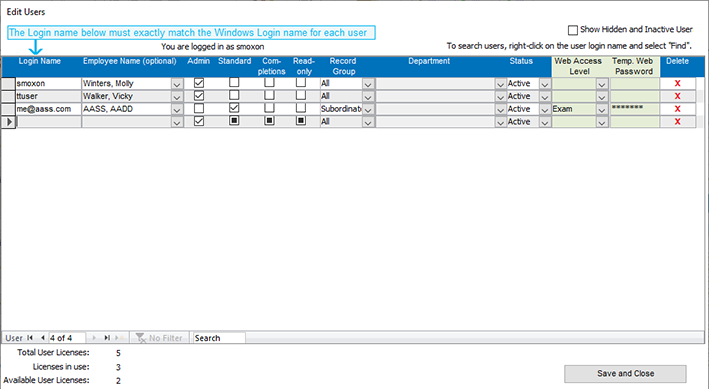
SECURITY AND USERS
Who Can Log In?
TRAIN TRACK® comes with built-in security measures. In addition, your database should be stored on a secure network, and only those with permission to use the application should have access to it through your network.
When you add employees to your database,TRAIN TRACK® automatically assigns them an Exam-level user login. You may edit the login to give them more permissions, and you may also add other people as users. You have full control over your users and their permissions.
When Exam-level users are created, they are assigned a default login and password which you may configure. Click here for more information.
User Levels
TRAIN TRACK® offers a variety of user access levels. You may assign each person a user access level. In the Client/Server edition, you may also restrict the employees they are able to view or edit.
Each user may be assigned an access level and an employee record group.
Each user may be assigned an access level:
Privileges -> User Level |
Edit users and settings |
Edit records |
Edit completions |
View records |
View their own training status |
Take an exam and open attached documents |
License required |
| Administrator | Yes |
Yes |
Yes |
Yes |
Yes |
Yes |
Yes |
| Standard | - |
Yes |
Yes |
Yes |
Yes |
Yes |
Yes |
| Completions | - |
- |
Yes |
Yes |
Yes |
Yes |
Yes |
| Read-only | - |
- |
- |
Yes |
Yes |
Yes |
Yes |
| Exam | - |
- |
- |
- |
Yes |
Yes |
- |
Each user may also be assigned an employee recordset (in the Client/Server edition):
There are many possible combinations of user levels. For example, you may assign a read-only user the ability to view only one department, or you could assign a completions user the ability to only edit training completions for their subordinates. The table below provides more details about which records may be viewed or edited.
Permissions |
Admin |
Standard |
Completions |
Read-only |
Exam |
Audit Trail |
Edit |
x |
x |
x |
x |
Automatic Shutdown |
Edit |
x |
x |
x |
x |
Default Grace Period |
Edit |
x |
x |
x |
x |
| Default Login and Password | Edit |
x |
x |
x |
x |
Delete Signed Records |
Edit |
x |
x |
x |
x |
| Email, Automatic | Edit |
x |
x |
x |
x |
| Email, Manual | Edit |
Edit |
x |
x |
x |
Employee Records |
Edit |
Edit |
Read |
Read |
x |
Exams (take an exam) |
Edit |
Edit |
Edit |
Edit |
Edit |
| Export | Edit |
Edit |
x |
x |
x |
| Import Completions | Edit |
Edit |
x |
x |
x |
| Import Employees | Edit |
Edit |
x |
x |
x |
| Import Exams | Edit |
Edit |
x |
x |
x |
| Import Requirements | Edit |
Edit |
|||
| Import Training | Edit |
Edit |
|||
| Linked Documents | Edit |
Edit |
Read |
Read |
Read |
Logo for Reports |
Edit |
x |
x |
x |
x |
Lookup Lists |
Edit |
Edit |
x |
Read |
x |
| My Completion Status | Read |
Read |
Read |
Read |
Read |
Password Expiration |
Edit |
x |
x |
x |
x |
Registration Code |
Edit |
x |
x |
x |
x |
Report Menu |
Read |
Read |
Read |
Read |
x |
Reset Passwords |
Edit |
x |
x |
x |
x |
| Restore Deleted Records | Edit |
Edit |
x |
x |
x |
Start Menu |
Read |
Read |
Read |
Read |
x |
Training Completions |
Edit |
Edit |
Edit |
Read |
x |
Training Records |
Edit |
Edit |
Read |
Read |
x |
Users |
Edit |
x |
x |
x |
x |
If you have the Client/Server with Web edition, the web-based user interface allows you to set up a separate set of users.
Edit Users
This section applies to Administrator, Standard, Completions, and Read-only users. Exam level users for the Client interface are managed separately (see below). If you also have the Web interface, we recommend allowing Exam-level users to log in through that interface. You may set them up through either interface.
To edit user names and levels, you need to be logged in as an administrator. If you are unable to log in as an administrator, you may still edit users if you have the original registration code (see Lockout Recovery below). By default, only active users are displayed.
Please note that user logins will update automatically when you update or import employee records.


If the total number of users requiring a license is greater than the number of users you are licensed for, you will be asked to remove some users.
To delete a user, click the red "x".
If you make changes to the level of the user that is logged in to TRAIN TRACK®, you will need to close and re-open it for your changes to take effect.
Exam Users
Exam level users who will log in through the Client interface are managed separately from other users. If you also have the Web interface, we recommend allowing Exam-level users to log in through that interface. You may set them up through either interface.
Exam level users for the Client interface do not need to have a Windows® login name in order to log in to take an exam. This way, if you have a shared computer that multiple employees will be using to take exams, they do not need to have a separate Windows® login. Instead, the exam level users will select their name and enter a password to open TRAIN TRACK®. The first time the employee logs in, they will be asked to set their own password. In order to control the distribution of passwords for employee access, we recommend supervising the initial login, to ensure that the identity of each user matches the login name they are using. You will need to verify their identity using your own procedures.
Web Interface Users and Inactive Users
If you also have the Web interface, your web users may also be managed from the Client interface. If you open the "Edit Users" screen, you may set permissions for Administrator, Standard or Limited web users. You may also view web Exam users by checking the box "Show Hidden and Inactive Users". This will display all of your users, including inactive users. To configure the default login name and temporary password for yout Web interface users, please see Options and Settings.
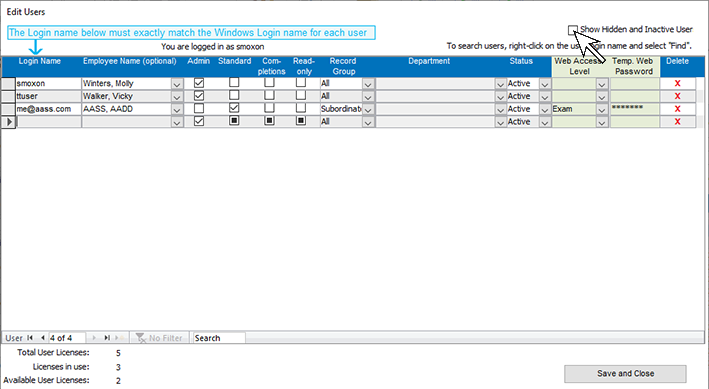
Reset Passwords
If an Exam-level user forgets their password, you may reset it for them.
To reset a password, follow these steps:

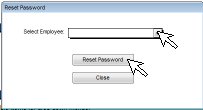
Password Expiration
To change password expiration, follow these steps:
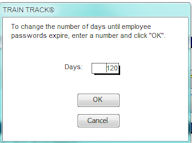
If you are unable to get to the Home Screen, and instead see the login box for the Exam Menu, this means your Windows® login is not listed as an administrator user. To edit users in this situation, if you have the original registration code, you may use the lockout recovery function.
To edit users if you are not listed as a user, follow these steps:
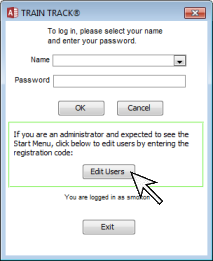
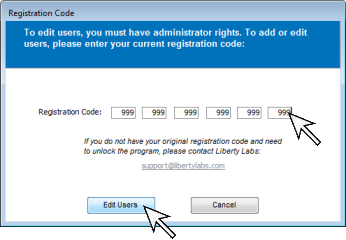
You may now add your user name in the Edit Users screen (see above).
Automatic Email Notices of Failed Logins
You may configure your application to automatically send alert emails to a designated email address when a user enters the incorrect password 3 times in a row (see automatic email).
